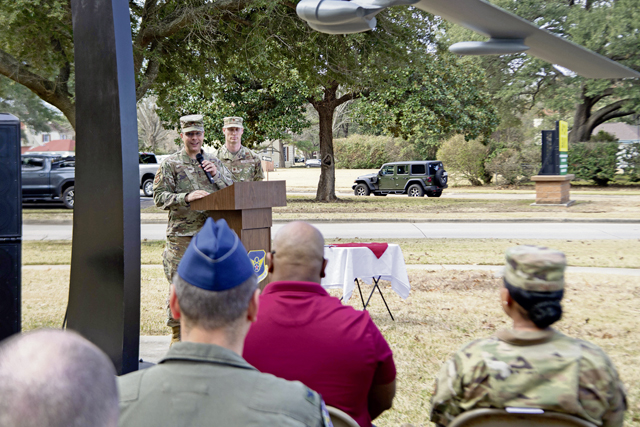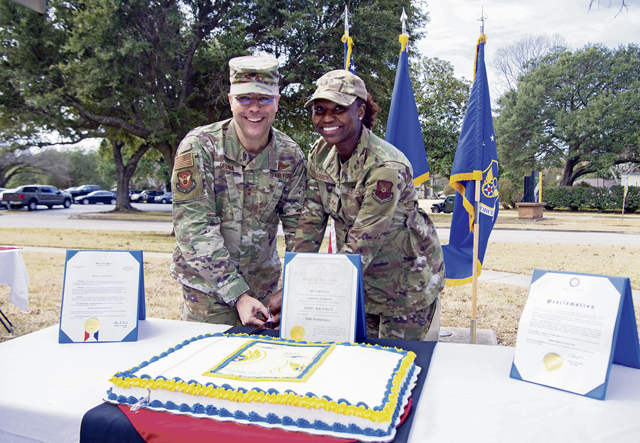On Feb. 1, 1942, the heritage, honors and lineage of the “Mighty Eighth” sprung to life. The Eighth Air Force’s story began during World War II and continues today with a charge to conduct indefinite strategic deterrence anytime, anywhere in order to safeguard the United States of America.
Eighth Air Force was first activated under the designation as the VIII Bomber Command on Feb. 1, 1942, at Langley Field, Virginia, and soon moved to England under its parent unit, 8th Air Force. Later that month on Feb. 22, 1944, the United States Army Air Forces reorganized its air headquarters in Europe with 8th Air Force becoming the United States Strategic Air Forces in Europe and on the same day, the VIII BC officially became known as 8th Air Force.

From its first air combat bombardment mission conducted on July 4, 1942, through the present use of standoff precision munitions, 8th Air Force has decisively taken the air battle into the enemy’s airspace and homeland.
“Eighth Air Force has an extensive history that dates back to World War II,” said Maj. Gen. Andrew Gebara, 8th Air Force and Joint-Global Strike Operations Center commander. “Our contributions and role during the war undeniably set the bar for airpower.”
By mid-1944, Eighth Air Force had reached a total strength of more than 200,000 people, and at its peak strength, Eighth Air Force could dispatch more than 2,000 four-engine heavy bombers and more than 1,000 fighters on a single mission. For these reasons, 8th Air Force became known as “The Mighty Eighth.”

The Mighty Eighth compiled an impressive war record during that time period, but with all the success also came sacrifices. Nearly half of the Army Air Force’s casualties in the war were suffered by 8th Air Force. Of the number of bombers and fighters lost, 33 percent were assigned to the Eighth.
Nonetheless, the dedicated warriors of 8th Air Force still garnered 17 Medal of Honor recipients ranging from general officer to enlisted ranks during World War II. And by the end of the war, the Mighty Eighth laid claim to the most aces, sorties, bomb tonnage dropped and aerial victories of the war.
“Bomber operations have and will continue to remain a vital component to U.S. strategic forces for many years to come,” said Gebara.
Over the next few decades, the Mighty Eighth would go through many expansions and modernizations and the inventory would eventually grow to encompass bombers, tankers and fighters.
“The Mighty Eighth’s long-range global strike capabilities continued to grow following WWII events,” said Lane Callaway, 8th Air Force historian.
Beginning in late 1959, the 8th Air Force gained missile systems and units, enabled to support two legs of the nation’s nuclear triad and would soon go on to conduct conventional bombing operations in Southeast Asia from the mid-sixties to early seventies.
The Mighty Eighth has participated in a string of contingency operations in support of bomber assurance and deterrence missions using the world’s most advanced and equipped bombers. The role bombers played in American airpower became even more pronounced following the events of 9/11.
The 8th Air Force headquarters supported the Commander-in-Chief with facilities and staff expertise when President George Bush aboard Air Force One landed at Barksdale. The President addressed the nation about the “9/11” attacks from Eighth Air Force’s commander’s conference room. Afterwards, the Mighty Eighth went on to participate in Operations Noble Eagle, Enduring Freedom, and Iraqi Freedom.
“One of the most significant organizational changes to date was in February 2010 when the Eighth Air Force was assigned to the new Air Force Global Strike Command,” said Callaway.
With a new mission of nuclear deterrence and global strike, all bomber forces, including the B-1, B-2, and B-52 fell under the Mighty Eighth umbrella.
But the Eighth Air Force of today is not just bombers anymore.
In October 2016, the 595th Command and Control Group located at Offutt Air Force Base realigned under the Mighty Eighth. This addition brought about the E-4B aircraft, aircrew and maintainers, as well as two strategic communication and operations squadrons into Eighth Air Force.
In the near future, the Eighth will boast their newest capability — the B-21 Raider — a long-range strike bomber, named after the surprise attack against Japan during WWII in 1942 — the Doolittle Raid. The B-21 Raider will be capable of penetrating the toughest defenses to deliver precision strikes anywhere in the world.
“I am extremely proud to be part of a unit with such a unique and responsive mission,” said Gebara. “From the beginning, 8th Air Force has played a major role in our nation’s defense and security, and we will continue bridging that legacy into the future.”


